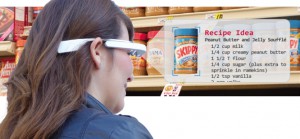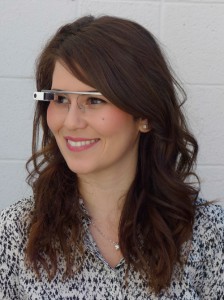 By Retail News Insider
By Retail News Insider
You’ve heard about wearable technology on the news and perhaps even seen a photo or two of a celeb or other well-connected tech-lover wearing Google’s new smart glasses, Google Glass, about town. But what exactly is it like to use Glass? And why is it—along with its smart bracelet, ring, watch and other wearable tech counterparts—becoming such a big deal? The Retail News Insider team recently took on the challenge to investigate the rise of wearable tech and whether it’s just another passing tech fad (remember those calculator watches from 1985?) or if it has real staying power. If you’re anything like us, the answers might just surprise you.
First, we headed to the offices of Interactions’ own Senior Vice President of IT, Abhi Beniwal, who was recently one of the lucky few given the opportunity to purchase Google Glass, currently available only by direct invite from Google. As Beniwal pulls out the wire-framed Glass, we can’t wait to get our hands on it. Lucky for us, he offers it up freely.
Putting it on, our first impressions are that it fits just like a pair of prescription eyewear, but instead of lenses, there’s a small screen in the upper corner of your right eye. It’s a little distracting at first. But our comfort quickly increases as we see all the things we can do with it—take pictures with a simple wink, post status updates just by talking and even get instant translations of signs in foreign languages—all without having to take our eyes off the world around us. Not to mention, we feel pretty cool wearing it.
Clearly Glass and other forms of wearable tech have a certain “cool kids club” appeal. But is there more to this technology than a passing fashion fad? Beniwal unequivocally says yes. “Wearable technology in some form or another is here to stay. It may seem like a fad in the mainstream now, but within the next two to five years, it will be integrated into all kinds of things that everyone uses and wears every day.”
If our collective years of experience in retail have shown us anything, it’s that every new breakthrough in technology impacts the way consumers communicate, interact and shop. Therein lies the answer to the “what’s the big deal?” question for retailers. In order to remain relevant to consumers, retailers will have to adapt to the demands for convenience, personalization and alternate engagement wearable tech will surely prompt. But it’s not entirely one-sided proposition. In embracing wearable teach, retailers can benefit in several key, bottom-line driving ways.

Retail News Insider tries out Google Glass
Strengthening the retailer-shopper bond
First and foremost, wearable tech offers retailers the opportunity to establish a strong connection with shoppers. It serves as a conduit for retailers to offer a truly hands-on (or body-on) experience, beyond what can be offered through mobile alone. Communication with shoppers can occur directly at all levels of the shopping cycle—while planning at home, shopping the aisles in-store and after leaving—and content can be customized based on information gathered from a variety of omnichannel sources. This not only provides shoppers with an enhanced retail experience, it also makes them feel more understood by and—perhaps as a result—more loyal to retailers, a proven means to increasing repeat sales.
Personalized service
Related to the above, retailers can also use wearable tech to provide a unique and personalized shopping experience for consumers. By integrating the best of mobile technologies, online convenience and in-store experiences, retailers can create a revitalized in-store environment that incorporates multichannel resources and engages customers. For example, say a shopper’s past purchase history indicates that he purchases steak every Friday. As he walks through the meat section one Friday night, the retailer could send a message through his smart watch to display a recipe for a complimentary steak side dish and wine pairing, along with photos of the exact product locations in the store.
By enhancing the retail experience and making routine shopping trips to the store more seamless and convenient in ways such as this, retailers can benefit from keeping customers engaged and driving conversion.
 Targeted advertising
Targeted advertising
Taking personalization and direct communication one step further, retailers could soon use wearable tech to enable hyper sensitive context-advertising. By tapping into the present-time activity customers partake in, retailers could offer targeted products at just the right time throughout the shopping cycle and without disrupting the consumer’s behavior. For example, as a consumer checks the face of her smart watch to view the progress of her fitness goals, an active gear retailer she has shopped with before could generate a running shoe ad and include a customized coupon to further spark her interest.
Improved engagement
In addition to catering to customers who are using wearable tech themselves, retailers may also benefit from equipping their own employees with these smart devices. This could allow front-line employees to deliver expanded services to in-store shoppers, both those who have their own wearable tech devices and those who don’t. For example, if a shopper asks an associate in the meat department about how to prepare a certain cut of meat, the associate could use retailer-issued smart glasses to instantly look up cooking guidelines and recipes. The associate could share the information with the customer and even offer to email it to him or her for handy reference when he or she gets home—all the while increasing the likelihood of sales conversion.
Of course, integrating wearable technology into existing retail systems will not be without its challenges. The legacy systems most large retailers use are notorious for being difficult to adapt. “Ultimately, retail systems built from the ground up will be the faster, more efficient way to get these new technologies out into the mainstream,” says Giovanni DeMeo, Interactions’ Vice President of Global Marketing and Analytics. “Forward-thinking retailers who have an appetite for delivering a better technology experience for customers stand to benefit greatly.”
Despite what some critics say, the reality is that wearable technology is at the forefront of the next technology wave. Progressive retailers who are quick to react and embrace it will be first in line to benefit from creating novel retail experiences that engage their customers, optimize conversion and drive sales.

